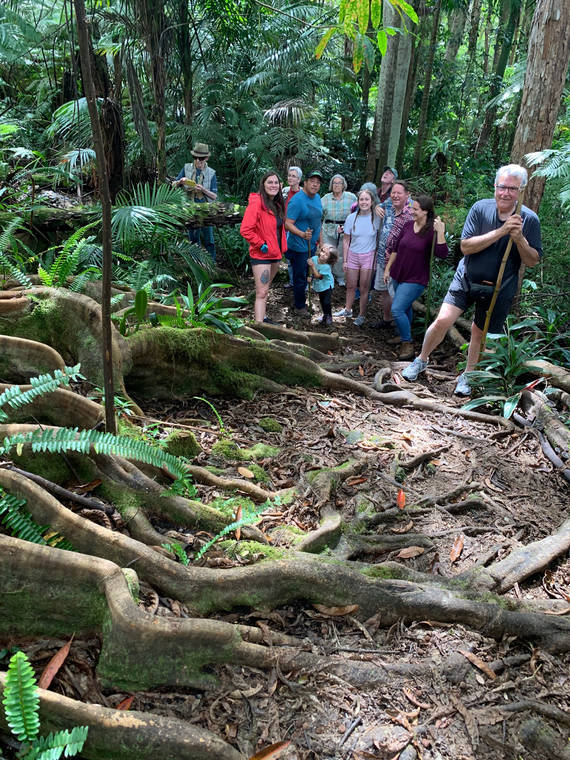Tropical Gardening: Islanders invited to tour Kona Cloud Forest Sanctuary

Courtesy of VOLTAIRE MOISE Residents on a tour in the Kona Cloud Forest Sanctuary wander through the montane tropical forest. This was Huehue ranch pastureland 35 years ago. What was once kikuyu grass is now a healthy oxygen-producing, carbon-sequestering forest.
We don’t know when things will get back to some sort of normal.
We don’t know when things will get back to some sort of normal.
But even with all these challenges, it is a perfect time to think of creative ways to live and learn.
ADVERTISING
If you want to learn more about the importance of our forests and the benefits they have on our peace of mind, then sign up for tours to be offered at Kona Cloud Forest Sanctuary. Call Janet Britt with Moku O Keawe Land Conservancy at 769-4343 or 937-1694 to reserve your space.
Because of the COVID-19 pandemic, we will be limited in the number of participants for classes and tours, so call early. We will be sure to take the recommended precautions, thus requiring the wearing of masks and social distancing to keep visitors safe.
Moku O Keawe Land Conservancy, the group sponsoring the hikes, is a nonprofit conservation organization established to protect land and water resources on the Big Island. Among its services, the conservancy sponsors educational events and hikes with the goal of educating our community about the importance of forests, open lands and waters.
Many of Hawaii’s forests and forest watersheds are threatened. We can do a lot to protect and plant forests here.
In East Hawaii, many ohia forest areas are subdivided into small lots of 1-3 acres. Unless the owners of the land really commit to protecting the forested lots, they are bulldozed and flattened.
In West Hawaii, the same situation occurs, with private lands being subdivided and cleared. One exception is the Kaloko Mauka subdivision. This is one of the most accessible native forests in West Hawaii.
Much of Kaloko Mauka is still covered with native forest. The area abounds with ancient ohia (Metrosideros polymorpha) and gigantic tree ferns, some of which are 30 feet or more in height. These ferns can be more than 100 years old since the trunks only grow 2-3 inches per year.
The native forest contains many rare and endangered species that local residents are committed to protect through the Hawaii Forest Stewardship and Hawaii Land Trust programs. These programs allow residents to dedicate and manage their properties to enhance this important and unique watershed.
In the heart of Kaloko Mauka, the 70-acre Kona Cloud Forest Sanctuary was set aside to demonstrate how to protect native forests. Approximately 15 acres that were previously Huehue ranch pasturelands were reforested with native and non-native species supplied by the forestry service, nurseries and plant societies for testing, such as palms, tree ferns, bamboos, tropical Rhododendrons, orchids and other plant materials.
Observations are being made as to their adaptability for reforestation and for agricultural and landscape use. Even though 80% of the sanctuary is preserved in native forest, upper portion is now reforested as a montane tropical forest and includes koa, ohia and conifers from the high tropics such as New Zealand and New Caledonia. Even California redwoods and Southeast loblolly pines are grown successfully.
The lower pasture was reforested with plants from warmer tropical regions and is referred to as the pan tropical forest.
Kaloko Mauka is the home of the Hawaiian hawk, apapane, iiwi, elepaio, amakihi and many other endemic and exotic birds. It was identified as essential wildlife habitat and forest watershed.
It is the goal of residents of Kaloko Mauka to set an example that they can live in harmony with the forest and still have homes and some forest-friendly agricultural activities. This is essential if our island is to have the rainfall and watershed needed to supply communities at lower elevations.
Not only is it vital to protect our remaining Hawaii forests, but to reforest those abandoned cane lands of Hamakua, Puna, Ka‘u and Kohala with biodiverse forests, thus ensuring valuable resources for future generations.
Remember the forests are the lungs of our planet!


